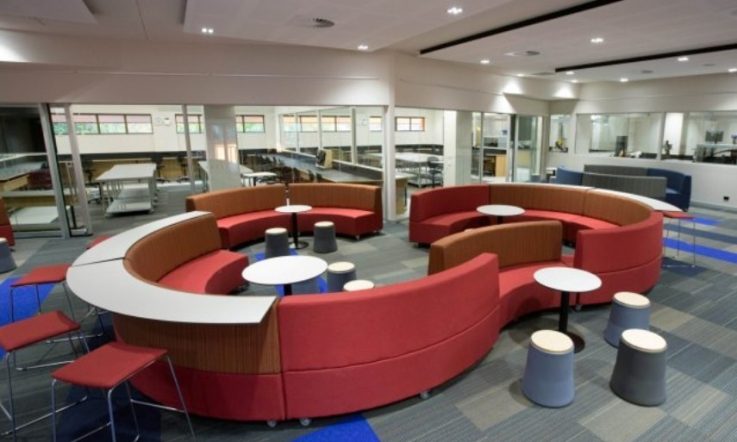What effect do different classroom seating arrangements have on student participation? What does your learning space reveal about your teaching philosophy? Should teachers or students decide who sits where? In today’s article, we take a look at what the research says.
Learning spaces come in all shapes and sizes, from rectangular rooms built for 30 students where you can close the door on the world but still peer through the window, to flexible, open-plan environments with folding walls where scores of students come together. Outdoors, indoors, subject-specific spaces with specialist equipment and multipurpose rooms for whole school use.
As a teacher, you don’t often get the chance to choose your classroom. However, the many fixtures and fittings means there’s a lot you can do to change the layout. Of course, once you’ve arranged your student desks, standing workstations, bean bags and other seating options (some educators even throw in exercise balls) you’ll likely next turn your attention to who sits where.
A classroom to support teaching and learning
So, how are you going to teach, what will the learning activity be and what do you want to achieve? Forty years ago, US environmental psychologist Professor Robert Sommer had this to say about choosing a classroom layout. ‘The teacher’s educational philosophy will be reflected in the layout of the classroom. The teacher should be able to justify the arrangement of desks and chairs on the basis of certain educational goals. There is no ideal classroom layout for all activities.' (Sommer, 1977)
He goes on to give a few examples: the traditional row and column style with all seats facing the front lends itself to ‘sit-and-listen teaching’; for group work, where students share tasks and cooperate ‘cluster tables are best’; and if you’re using equipment that needs some space, such as Cuisenaire rods in mathematics, then you’re going to need long tables.
Do certain seating arrangements encourage participation?
A study involving a class of fourth graders in Germany (Marx, Fuhrer & Hartig, 1999) looked at whether different seating arrangements led to students asking more questions. The researchers observed 53 German and maths lessons over eight weeks and in all cases the teacher was at the front – either sitting at her desk or standing.
They tested two seating arrangements – traditional rows and columns and a semicircle. ‘Our results showed that question-asking was more frequent when the children were seated in the semicircular arrangement than in the row-and-column arrangement,’ the researchers report. Interestingly, in both arrangements, even the rows and columns, they found two ‘action zones’ – one shaped like a T and the other like a triangle. Children in these zones (those with a more central seating location) asked more questions per lesson.
They say the results of their study suggest arranging seating in a semicircle in primary school ‘could lead to equal opportunities for everyone in the class’ but caution that, when it comes to student participation, factors such as teacher personality and their teaching style shouldn’t be ruled out.
Fernandes, Huang & Rinaldo (2011) say research has shown that participation and engagement is beneficial for student learning. ‘Classroom participation is associated with the generation and promotion of higher order thinking skills, and this cognitive stimulation provides students with a different environment which promotes positive and effective learning experiences …’.
Looking at things from a student perspective
During a visit to the cinema or a sporting event, there’s always a chance you’ll arrive at your seat and discover you’ve got a ‘restricted view’. Or (usually five minutes before the start) someone with the height and physique of Jonah Lomu will take their seat … the one that’s right in front of yours.
In a classroom environment, if your desks are in clusters – unless you’ve got a really big space to work with – it’s difficult to find a solution where at least one or two students don’t have their backs to the board. But, there are other things to consider.
Sommer argues that, far from being a ‘single homogenous space cube’ a classroom is lots of connected micro-environments. ‘The lighting is much better in one part of the room than elsewhere, it is cold over by the windows, and perhaps too warm by the heating vent. The view of the blackboard differs dramatically from one part of the room to another often because of a glare from the ceiling lights.’
This advice dates back to the 1970s but it’s still relevant today. With BYOD and one-to-one laptops, and electronic smartboards, screen glare from ceiling lights and windows can be a problem. And there’s more. Sommer adds: ‘A few students may have an outside view, others don’t. Someone may be teaching in a room for years without realizing the students in a quadrant of the room will have difficulty seeing the blackboard or charts. There may also be a physical barrier between students in the rear and portions of the blackboard, such as a tall student in a front desk.’
When was the last time you looked at things from a student perspective? Have you put yourselves in their shoes (or seat, in this case) or even checked with everyone if they can see and hear properly?
Deciding who sits where
In primary settings, it’s often the teacher who decides where students sit. In secondary, where you’re not based in one classroom for most or all of the day, some teachers are happy to let students choose a seat at the start of each lesson.
Fernandes, Huang & Rinaldo (2011) say it would be good for students if the learning activity dictated the seating. On the topic of giving a free choice of seats, they point out the learning experience for students is different for those at the front than for those nearer the back of the room. And, throwing it open to students to decide means some will get a better pick than others. ‘Students who enter the classroom first may be in the position to select desirable seats first; thus, those who are unable to come first may be left with seats they do not desire …’
As a teacher, if you’re deciding who sits where there can be lots of reasons for your choices. It could be about a group task involving specific students, it could be about ability (for example, grouping similar abilities or setting up cluster tables to encourage peer support), or it could be about behaviour management (for example, putting space between certain students, or moving some closer to your own desk).
A recent study in the Netherlands explored not only the different types of seating arrangements in elementary schools, but also the teachers’ considerations for deciding who sits where (Gremmen, van den Berg, Segers, & Cillessen, 2016).
‘At the beginning of the school year, as part of classroom management, teachers face the question of how and where to seat their students. This is an important decision, as classroom seating arrangements influence classroom climate and students’ relationships with each other …,’ they note.
‘[Teachers] determine whom students sit close to, whom they are exposed to, and with whom they interact during the school day. Unfortunately, this aspect of classroom management is hardly addressed in teacher trainings, even though the physical design of the classroom has shown to be important for both the academic and social development of students.’
When asked about opting for certain classroom arrangements, the 50 teachers in the study mentioned between two and 19 reasons – most of them were academic (31 per cent) but 17 per cent of the reasons were related to classroom management. Almost half of the teachers in the study (48 per cent), chose to divide students into small groups, 40 per cent chose rows and 12 per cent chose a different arrangement.
The researchers found: ‘The most frequently mentioned reason for small groups was cooperation between students, whereas teachers who chose rows did so to create a quiet atmosphere in which students can work well academically.’ Interestingly, more teachers (70 per cent) actually preferred small groups but they didn’t always opt for that arrangement, particularly at the start of the year. ‘Teachers mentioned they start with rows in the beginning of the school year to get students to concentrate and try to work with groups later in the year.’
Which brings us back to Sommer’s suggestion to choose something that works for you and your students, in your context, at that particular point in time.
References
Fernandes, A. C., Huang, J., & Rinaldo, V. (2011). Does where a student sits really matter? The impact of seating locations on student classroom learning. International Journal of Applied Educational Studies, 10(1), 66-77.
Gremmen, M. C., van den Berg, Y. H., Segers, E., & Cillessen, A. H. (2016). Considerations for classroom seating arrangements and the role of teacher characteristics and beliefs. Social Psychology of Education, 19(4), 749-774.
Marx, A., Fuhrer, U., & Hartig, T. (1999). Effects of classroom seating arrangements on children's question-asking. Learning Environments Research, 2(3), 249-263.
Sommer, R. (1977). Classroom layout. Theory into Practice, 16(3), 174-175.
When was the last time you looked at your classroom layout from a student perspective? Do you regularly check if everyone can see and hear properly?
Does the learning activity dictate the seating arrangement in your classroom? Do you change your layout according to different activities or at different times of the year?
Can you justify your choice of classroom seating arrangement on the basis of educational goals?



